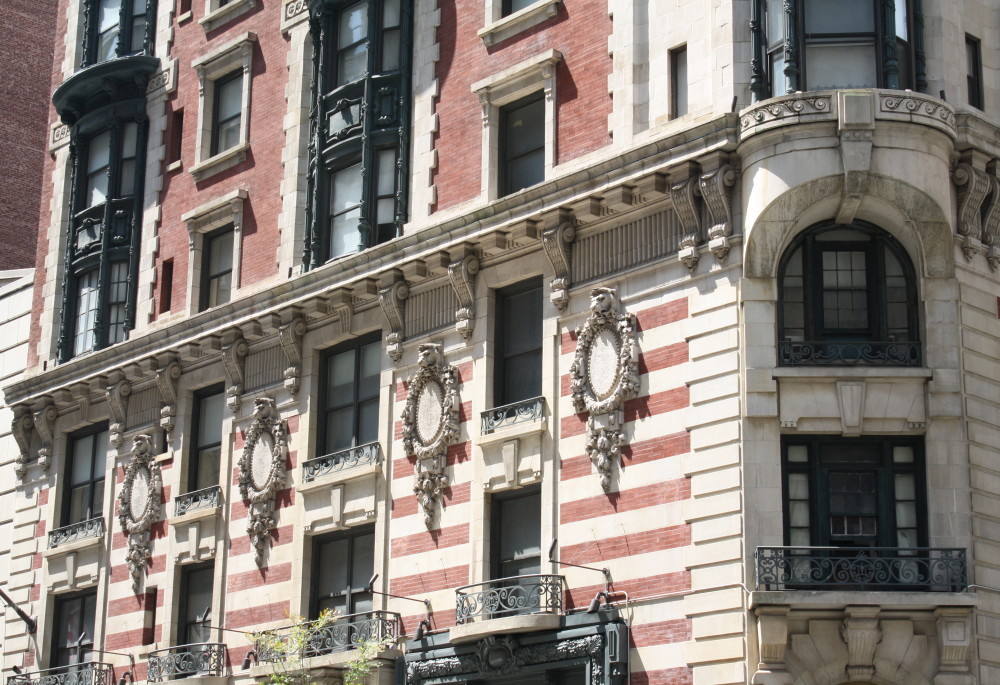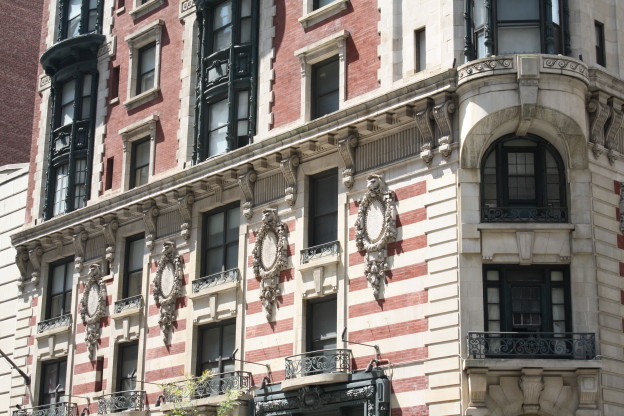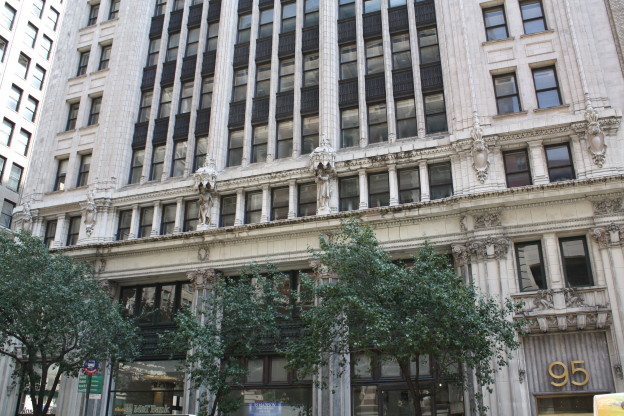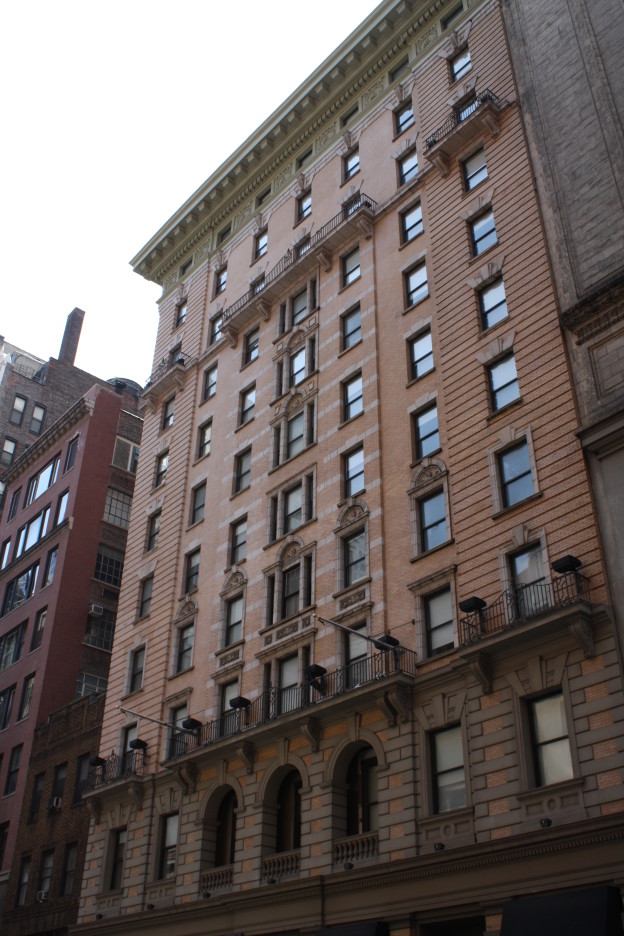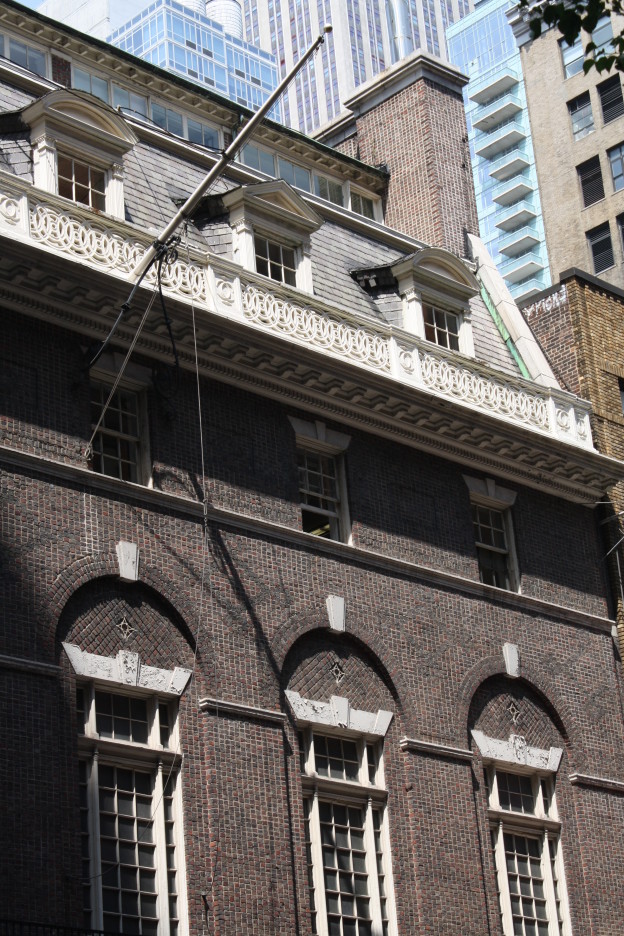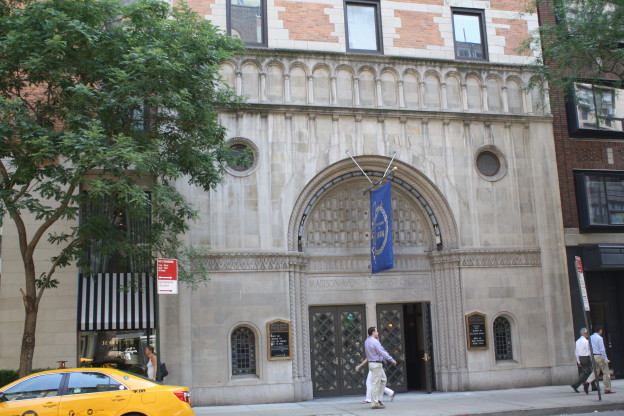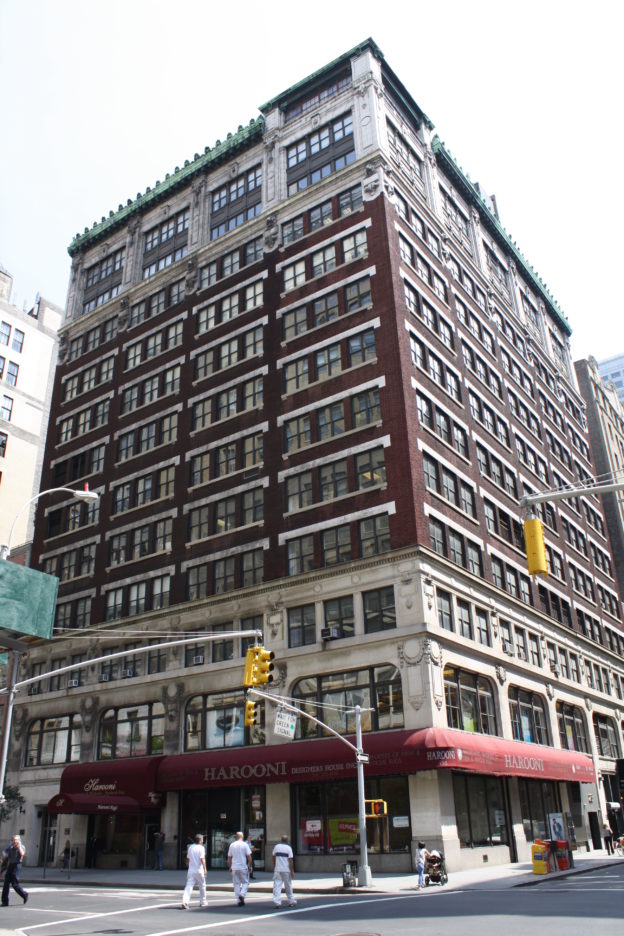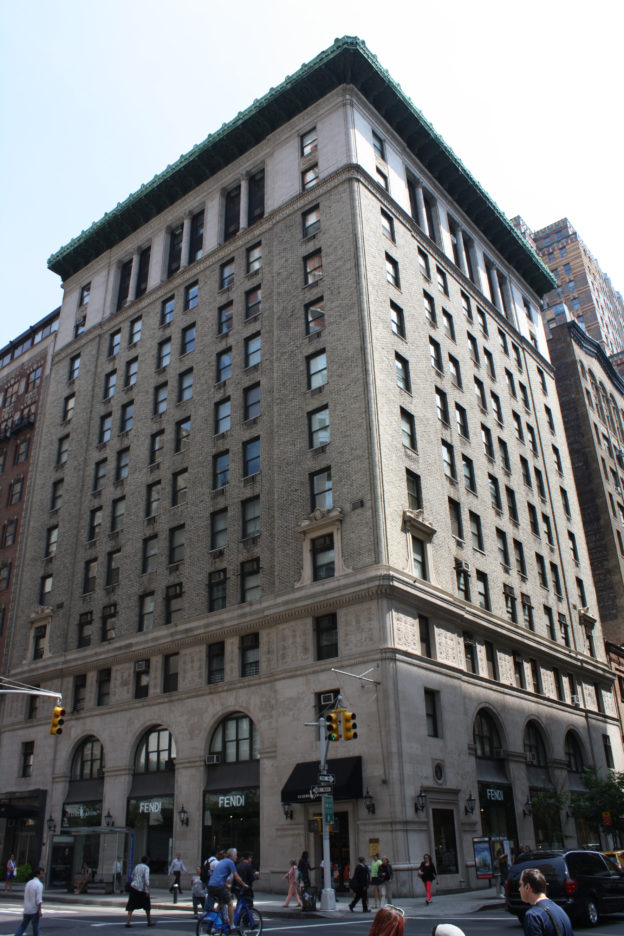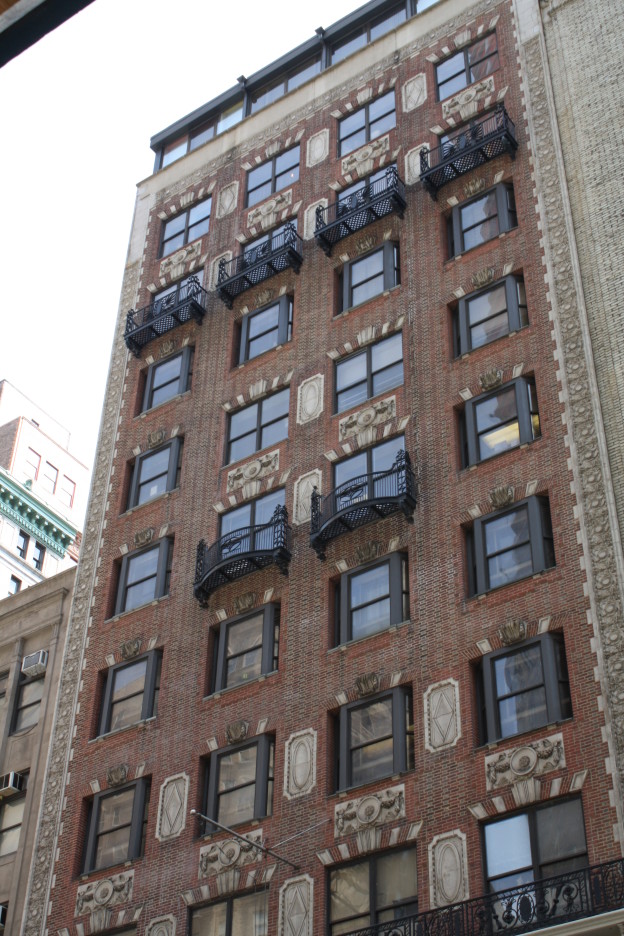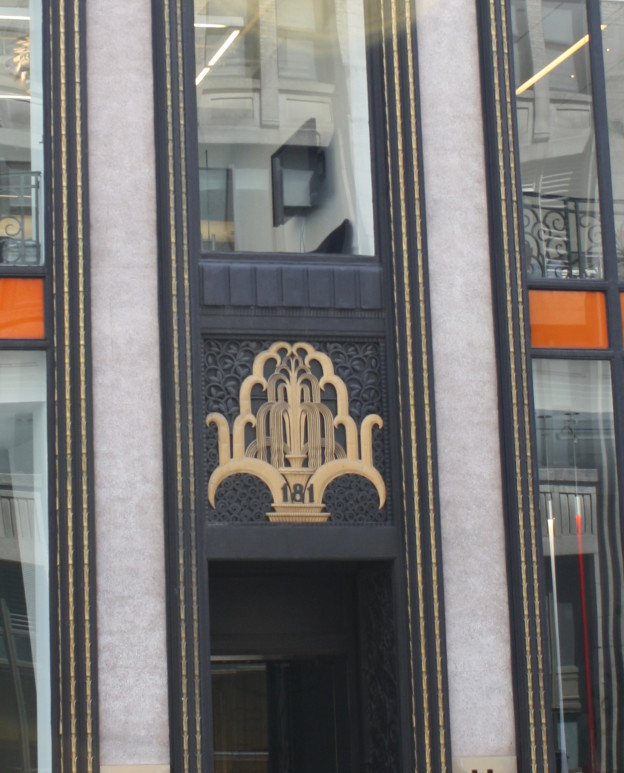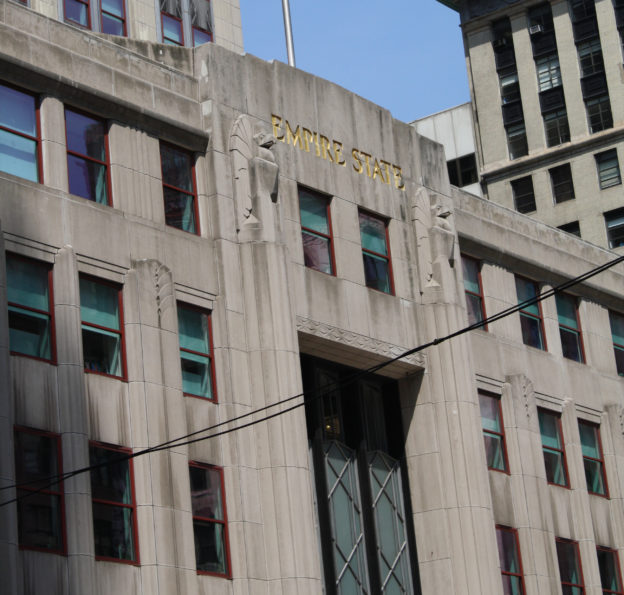90 Madison Avenue;
Harry Allen Jacobs, 1901-03; annex: c. 1905|
Like Madison Square Park, Madison Avenue was named after James Madison, the fourth President of the United States. The Avenue begins at 23rd Street and extends to the Madison Avenue Bridge at 138th Street. When the Manhattan street grid was mandated in 1811, there was no avenue between Fourth (now Park) and Fifth Avenues. Madison Avenue was carved out in the 1840s due to the wide distance between Fourth and Fifth Avenues and in order to create more building lots with avenue frontage. This southern section of Madison Avenue is characterized by its fine assortment of large-scale hotels, lofts and office buildings.
The Former Hotel Seville (currently the Carlton Hotel) replaced the former Scottish Rite Hall. The elegant Beaux-Arts hotel features red brick and limestone façades with a rusticated base, alternating bandcourses at the second and third stories, decorative cornices and projecting bays from the fourth to the tenth stories. One of these bays is located at the building’s chamfered corner, which is clad in limestone along the building’s full height. An annex between 28th and 29th Streets was added a few years after its construction.
95 Madison Avenue;
Barney & Colt, 1911|
Like Madison Square Park, Madison Avenue was named after James Madison, the fourth President of the United States. The Avenue begins at 23rd Street and extends to the Madison Avenue Bridge at 138th Street. When the Manhattan street grid was mandated in 1811, there was no avenue between Fourth (now Park) and Fifth Avenues. Madison Avenue was carved out in the 1840s due to the wide distance between Fourth and Fifth Avenues and in order to create more building lots with avenue frontage. This southern section of Madison Avenue is characterized by its fine assortment of large-scale hotels, lofts and office buildings.
The Emmet Building was constructed for Dr. Thomas Addis Emmet, a prominent physician and advocate for Irish independence. He commissioned the 15-story office building on this site, where the home he lived in for more than 40 years had been situated. Like number 105, this striking Renaissance Revival style building is also clad in terra-cotta and features elaborate Gothic Revival ornament.
East of Madison on East 30th Street;
Robert Gibson, 1901|
Like Madison Square Park, Madison Avenue was named after James Madison, the fourth President of the United States. The Avenue begins at 23rd Street and extends to the Madison Avenue Bridge at 138th Street. When the Manhattan street grid was mandated in 1811, there was no avenue between Fourth (now Park) and Fifth Avenues. Madison Avenue was carved out in the 1840s due to the wide distance between Fourth and Fifth Avenues and in order to create more building lots with avenue frontage. This southern section of Madison Avenue is characterized by its fine assortment of large-scale hotels, lofts and office buildings.
The Martha Washington Hotel stands just east of Madison on East 30th Street. The 12-story Renaissance Revival style building was the first hotel built to house professional women in New York City, a function it served until 1998 when it was converted to a regular hotel. The brick and limestone structure features prominent quoins, Palladian windows, splayed lintels and iron balconettes. The Martha Washington Hotel was designated a New York City Individual Landmark in 2012.
120 Madison Avenue;
McKim, Mead & White, 1905|
Like Madison Square Park, Madison Avenue was named after James Madison, the fourth President of the United States. The Avenue begins at 23rd Street and extends to the Madison Avenue Bridge at 138th Street. When the Manhattan street grid was mandated in 1811, there was no avenue between Fourth (now Park) and Fifth Avenues. Madison Avenue was carved out in the 1840s due to the wide distance between Fourth and Fifth Avenues and in order to create more building lots with avenue frontage. This southern section of Madison Avenue is characterized by its fine assortment of large-scale hotels, lofts and office buildings.
The Federal Eclectic style American Academy of Dramatic Arts/Colony Club is a graceful six-story structure of red brick with limestone trim. This Individual Landmark features a shallow balcony supported by pilasters at the ground level, five arched window openings at the second story, a perforated stone cornice and five dormer windows at its crown. The Colony Club was the first women’s organization in the city to build itself a club house for social and recreational activities.
129 Madison Avenue;
Jardine, Hill & Murdock, 1930|
Like Madison Square Park, Madison Avenue was named after James Madison, the fourth President of the United States. The Avenue begins at 23rd Street and extends to the Madison Avenue Bridge at 138th Street. When the Manhattan street grid was mandated in 1811, there was no avenue between Fourth (now Park) and Fifth Avenues. Madison Avenue was carved out in the 1840s due to the wide distance between Fourth and Fifth Avenues and in order to create more building lots with avenue frontage. This southern section of Madison Avenue is characterized by its fine assortment of large-scale hotels, lofts and office buildings.
The Roger Williams Hotel/Madison Avenue Baptist Church replaced the 1858 Madison Avenue Baptist Church structure that originally stood on this site. In 1930, this residential hotel was constructed with the church incorporated into its first four stories. The building’s Romanesque Revival style recalls the architecture of the original church.
135 Madison Avenue;
J. B. Snook’s sons, 1910|
Like Madison Square Park, Madison Avenue was named after James Madison, the fourth President of the United States. The Avenue begins at 23rd Street and extends to the Madison Avenue Bridge at 138th Street. When the Manhattan street grid was mandated in 1811, there was no avenue between Fourth (now Park) and Fifth Avenues. Madison Avenue was carved out in the 1840s due to the wide distance between Fourth and Fifth Avenues and in order to create more building lots with avenue frontage. This southern section of Madison Avenue is characterized by its fine assortment of large-scale hotels, lofts and office buildings.
The Terry & Tench Building was named for the iron company that erected the building. Terry & Tench was also responsible for the steel construction of the Manhattan Bridge and Grand Central Terminal. This loft building was designed in the Edwardian style, a late Victorian style popular between 1901 and 1914 characterized by understated Classical influences.
159 Madison Avenue;
Wallis & Goodwillie, 1911-12|
Like Madison Square Park, Madison Avenue was named after James Madison, the fourth President of the United States. The Avenue begins at 23rd Street and extends to the Madison Avenue Bridge at 138th Street. When the Manhattan street grid was mandated in 1811, there was no avenue between Fourth (now Park) and Fifth Avenues. Madison Avenue was carved out in the 1840s due to the wide distance between Fourth and Fifth Avenues and in order to create more building lots with avenue frontage. This southern section of Madison Avenue is characterized by its fine assortment of large-scale hotels, lofts and office buildings.
The Manice Building is a 12-story, Renaissance Revival style loft building, with arched openings at the ground level and a large, bracketed, overhanging cornice.
161 Madison Avenue;
Israels & Harder, 1902|
Like Madison Square Park, Madison Avenue was named after James Madison, the fourth President of the United States. The Avenue begins at 23rd Street and extends to the Madison Avenue Bridge at 138th Street. When the Manhattan street grid was mandated in 1811, there was no avenue between Fourth (now Park) and Fifth Avenues. Madison Avenue was carved out in the 1840s due to the wide distance between Fourth and Fifth Avenues and in order to create more building lots with avenue frontage. This southern section of Madison Avenue is characterized by its fine assortment of large-scale hotels, lofts and office buildings.
The Beaux-Arts style former Warrington Hotel features rich ornament, including sculpted panels, brackets, iron balconies and limestone quoins. It was originally built as a residential hotel.
81 Madison Avenue;
Warren & Wetmore, 1924|
Like Madison Square Park, Madison Avenue was named after James Madison, the fourth President of the United States. The Avenue begins at 23rd Street and extends to the Madison Avenue Bridge at 138th Street. When the Manhattan street grid was mandated in 1811, there was no avenue between Fourth (now Park) and Fifth Avenues. Madison Avenue was carved out in the 1840s due to the wide distance between Fourth and Fifth Avenues and in order to create more building lots with avenue frontage. This southern section of Madison Avenue is characterized by its fine assortment of large-scale hotels, lofts and office buildings.
The Madison Belmont Building was constructed for the Cheney Brothers Silk Company, the country’s largest silk mill at the time, when this area was briefly known as the Silk District. Its overall Renaissance Revival style is accented by prominent Art Deco elements, and was one of the first buildings in the United States to incorporate such motifs. Its elegant iron and bronze framing at the lower three floors and entrances was designed by Edgar Brandt, a pioneer of the Art Deco style in Paris. The building was designated both an Individual and Interior Landmark in 2011.
350 Fifth Avenue, William F. Lamb of Shreve, Lamb and Harmon, 1929-31;
Renwick, Aspinwall & Russell, 1889|
At the corner of 33rd Street and Fifth Avenue, one can look up at the Empire State Building, a New York City and American icon. Its varied massing and impressive height are on especially prominent display from this vantage point, as is its Art Deco entrance on Fifth Avenue. An interesting juxtaposition just across the street to the east is the Renaissance Revival style carriage store at number 339, a rare survivor in this midtown context. The rather squat, but strong building features three-story, round-arch windows on both the Fifth Avenue and 33rd Street façades, as well as ornamental roundels between the arches, panels at the roofline and a dentilled cornice.
The Empire State Building was designed a New York City Individual Landmark and an Interior Landmark in 1981.
